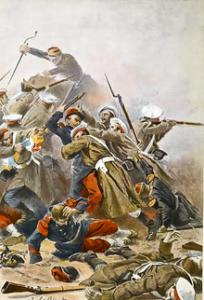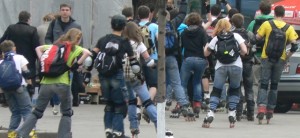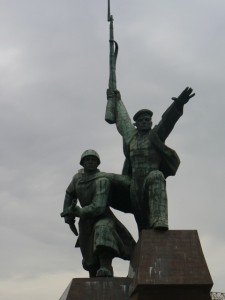I am reading a biography of Leo Tolstoy, the irascible and wordy Russian novelist who in his long and restless life went to participate in the Crimean War (1853-56) between Russia and the combined forces France & England, the Ottomans and Sardinians. (photo right) The struggle was for power over territories of the fading Ottoman empire. The location was southern Ukraine, now an independent country that broke out of the Soviet sphere in 1994.
between Russia and the combined forces France & England, the Ottomans and Sardinians. (photo right) The struggle was for power over territories of the fading Ottoman empire. The location was southern Ukraine, now an independent country that broke out of the Soviet sphere in 1994.
My recent 2012 trip to the scene of much of the war, in the Crimean peninsula, was shadowed daily by reminder war memorials to all the bloody battles fought there. These included the wars that preceded and followed the Crimean War. The area has been an historic combat field for millennia: the Greeks and Romans invaded in the centuries before the Common Era (BCE).
Walking the quiet streets of Crimea today, in Sebastopol, Yalta and Balaklava town is a universe removed from those devastating 19th century days when men suffered severe wounds from inferior weapons and medical care was primitive (but improved  a bit by the presence of Florence Nightingale).
a bit by the presence of Florence Nightingale).
Today, teen skaters and skateboarders glide along the parks, city streets, marble walls or any other smooth surface (photo left) including the steps of the impressive and massive World War II monument in Sevastopol.
Tolstoy turned his Crimean experiences into news reports and wove them into his best-known novels, ‘War and Peace’ and ‘Anna Karenina’. His description of the senseless death and agony of the dying as well as the blunders of the Crimean commanders resonates down through the century as literature.
But not for these city kids in baggy jeans, hoods and wool hats. Their focus is hardly the past, hardly the monsters of history. They are oblivious what the war memorials are for or what significance they have on life today. They haven’t forgotten the p ast, they hardly know it exists.
ast, they hardly know it exists.
Twenty miles south of Sebastopol port, where the Russians still have a modest naval fleet, there is a small town of Balaklava where Ukraine’s most daunting military museum is located (photo right). It’s an enormous curved, quarter-circle tunnel that was dug under a mountain at sea level as a top secret Soviet submarine base in the 1960’s.
For fifty years it was indeed a secret virtually invisible from the outside because of the town’s hidden harbor and the two-foot-thick entry portal doors that kept out strangers. Tolstoy would have marveled at such engineering, laborious effort and bizarre politics.
He would have scowled that such great effort, money and human resources were thrown at this defensive tunnel of war (from which no subs were ever sent into combat). No doubt he would have composed yet another book and called it ‘The Foibles of War and the Indifference of Peace’, with all the same death and destruction (by  Stalin and Hitler), all followed by the same forgetting of wasted lives and unused weapons. (photo left, war memorial in Sevastopol)
Stalin and Hitler), all followed by the same forgetting of wasted lives and unused weapons. (photo left, war memorial in Sevastopol)
Some claim such Cold War redoubts as this submarine base secured a peace. Perhaps. Others argue it prolonged the Cold War. Non-combat face-offs are open to all manner of interpretation from all sides.
Meanwhile the skaters are busy perfecting their riding skills, oblivious to these historic meanings; skating over the past. The lessons of long-gone deaths, war strategies, failed politics, famine and persecution are nothing compared to the breeze on a teenager’s face in a long skate downhill.
Richard Ammon
GlobalGayz.com
April 26, 2012
















